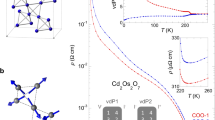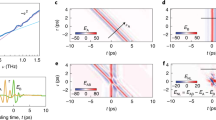Abstract
The distinction between metals, semiconductors and insulators depends on the behaviour of the electrons nearest the Fermi level EF, which separates the occupied from the unoccupied electron energy levels. For a metal, EF lies in the middle of a band of electronic states, whereas EF in insulators and semiconductors lies in the gap between states. The temperature-induced transition from a metallic to an insulating state in a solid is generally connected to a vanishing of the low-energy electronic excitations1. Here we show the first direct evidence of a counter-example, in which a significant electronic density of states at the Fermi energy exists in the insulating regime. In particular, angle-resolved photoemission data from the colossal magnetoresistive oxide La1.24Sr1.76Mn2O7 show clear Fermi-edge steps, both below the metal–insulator transition temperature TC, when the sample is globally metallic, and above TC, when it is globally insulating. Further, small amounts of metallic spectral weight survive up to temperatures more than twice TC. Such behaviour may also have close ties to a variety of exotic phenomena in correlated electron systems, including the pseudogap temperature in underdoped cuprates2.
This is a preview of subscription content, access via your institution
Access options
Subscribe to this journal
Receive 12 print issues and online access
$259.00 per year
only $21.58 per issue
Buy this article
- Purchase on SpringerLink
- Instant access to full article PDF
Prices may be subject to local taxes which are calculated during checkout




Similar content being viewed by others
References
Imada, M., Fujimori, A. & Tokura, Y. et al. Metal–insulator transitions. Rev. Mod. Phys. 70, 1039–1263 (1998).
Timusk, T. & Statt, B. The pseudogap in high-temperature superconductors: An experimental survey. Rep. Prog. Phys. 62, 61–122 (1999).
Li, Q. A., Gray, K. E. & Mitchell, J. F. Spin-independent and spin-dependent conductance anisotropy in layered colossal-magnetoresistive manganite single crystals. Phys. Rev. B 59, 9357–9361 (1999).
Sun, Z. et al. Quasiparticlelike peaks, kinks, and electron-phonon coupling at the (π,0) regions in the CMR oxide La2−2xSr1+2xMn2O7 . Phys. Rev. Lett. 97, 056401 (2006).
Dessau, D. S. et al. k-dependent electronic structure, a large “ghost” Fermi surface, and a pseudogap in a layered magnetoresistive oxide. Phys. Rev. Lett. 81, 192–195 (1998).
Chuang, Y.-D. et al. Fermi surface nesting and nanoscale fluctuating charge/orbital ordering in colossal magnetoresistive oxides. Science 292, 1509–1513 (2001).
Saitoh, T. et al. Temperature-dependent pseudogaps in colossal magnetoresistive oxides. Phys. Rev. B 62, 1039–1043 (2000).
Mannella, N. et al. Nodal quasiparticle in pseudogapped colossal magnetoresistive manganites. Nature 438, 474–478 (2005).
Dessau, D. S. et al. Anomalous spectral weight transfer at the superconducting transition of Bi2Sr2CaCu2O8+δ . Phys. Rev. Lett. 66, 2160–2163 (1991).
Shen, Z.-X. & Dessau, D. S. Electronic structure and photoemission studies of late transition-metal oxides—Mott insulators and high-temperature superconductors. Phys. Rep. 253, 1–162 (1995).
Damascelli, A., Hussain, Z. & Shen, Z.-X. Angle-resolved photoemission studies of the cuprate superconductors. Rev. Mod. Phys. 75, 473–541 (2003).
Voit, J. One-dimensional Fermi liquids. Rep. Prog. Phys. 57, 977–1116 (1995).
Allen, J. W. Quasiparticles and their absence in photoemission spectroscopy. Solid State Commun. 123, 469–487 (2002).
Varma, C. M. Electronic and magnetic states in the giant magnetoresistive compounds. Phys. Rev. B 54, 7328–7333 (1996).
Argyriou, D. N. et al. Two-dimensional ferromagnetic correlations above TC in the naturally layered CMR manganite La2−2xSr1+2xMn2O7 (x=0.3–0.4). J. Appl. Phys. 83, 6374–6378 (1998).
Osborn, R. et al. Neutron scattering investigation of magnetic bilayer correlations in La1.2Sr1.8Mn2O7: Evidence of canting above TC . Phys. Rev. Lett. 81, 3964 (1998).
Rosenkranz, S. et al. Observation of Kosterlitz–Thouless spin correlations in the colossally magnetoresistive layered manganite La1.2Sr1.8Mn2O7. Preprint at <http://www.arxiv.org/abs/cond-mat/9909059> (1999).
Rosenkranz, S. et al. Spin correlations and magnetoresistance in the bilayer manganite La1.2Sr1.8Mn2O7 . Physica B 312–313, 763–765 (2002).
Uehara, M., Mori, S., Chen, C. H. & Cheong, S.-W. Percolative phase separation underlies colossal magnetoresistance in mixed-valent manganites. Nature 399, 560–563 (1999).
Dagotto, E. Nanoscale Phase Separation and Colossal Magnetoresistance: The Physics of Manganites and Related Compounds (Springer, Berlin, 2003).
Argyriou, D. N. et al. Glass transition in the polaron dynamics of colossal magnetoresistive manganites. Phys. Rev. Lett. 89, 36401 (2002).
Dagotto, E. Complexity in strongly correlated electronic systems. Science 309, 257–262 (2005).
Tokura, Y. Critical features of colossal magnetoresistive manganites. Rep. Prog. Phys. 69, 797–851 (2006).
Burgy, J., Mayr, M., Martin-Mayor, V., Moreo, A. & Dagotto, E. Colossal effects in transition metal oxides caused by intrinsic inhomogeneities. Phys. Rev. Lett. 87, 277202 (2001).
Griffiths, R. B. Nonanalytic behavior above the critical point in a random Ising ferromagnet. Phys. Rev. Lett. 23, 17 (1969).
Salamon, M. B., Lin, P. & Chun, S. H. Colossal magnetoresistance is a Griffiths singularity. Phys. Rev. Lett. 88, 197203 (2002).
Emery, V. J. & Kivelson, S. A. Importance of phase fluctuations in superconductors with small superfluid density. Nature 374, 434–437 (1995).
Murakami, S. & Nagaosa, N. Colossal magnetoresistance in manganites as a multicritical phenomenon. Phys. Rev. Lett. 90, 197201 (2003).
Mitchell, J. et al. Spin, charge and lattice states in layered magneto-resistive oxides. J. Phys. Chem. B 105, 10731–10745 (2001).
Kubota, M. et al. Relation between crystal and magnetic structures of layered maganite La2−2xSr1+2xMn2O7 (0.30≤x≤0.50). J. Phys. Soc. Jpn 69, 1606–1609 (2000).
Vasiliu-Doloc, L. et al. Charge melting and polaron collapse in La1.2Sr1.8Mn2O7 . Phys. Rev. Lett. 83, 4393–4396 (1999).
Acknowledgements
The authors thank K. Gray for the resistivity data of Fig. 1a and Y. Tokura and T. Kimura for providing preliminary samples, and are grateful to D. N. Argyriou, A. Bansil, E. Dagotto, K. Gray, A. Moreo, R. Osborn, L. Radzihovsky, D. Reznik, S. Rosenkranz, Y. Tokura and M. Veillette for helpful discussions. Primary support for this work came from US National Science Foundation grant DMR 0402814, with other support from the US Department of Energy under grant DE-FG02-03ER46066. The Advanced Light Source is supported by the Director, Office of Science, Office of Basic Energy Sciences, US Department of Energy, under contract No. DE-AC02-05CH11231. Argonne National Laboratory, a US Department of Energy Office of Science Laboratory, is operated under contract No. DE-AC02-06CH11357. The US Government retains for itself, and others acting on its behalf, a paid-up non-exclusive, irrevocable worldwide license in said article to reproduce, prepare derivative works, distribute copies to the public and perform publicly and display publicly, by or on behalf of the government.
Author information
Authors and Affiliations
Corresponding authors
Ethics declarations
Competing interests
The authors declare no competing financial interests.
Supplementary information
Rights and permissions
About this article
Cite this article
Sun, Z., Douglas, J., Fedorov, A. et al. A local metallic state in globally insulating La1.24Sr1.76Mn2O7 well above the metal–insulator transition. Nature Phys 3, 248–252 (2007). https://doi.org/10.1038/nphys517
Received:
Accepted:
Published:
Issue date:
DOI: https://doi.org/10.1038/nphys517
This article is cited by
-
Quantifying the critical thickness of electron hybridization in spintronics materials
Nature Communications (2017)
-
Decoding Spatial Complexity in Strongly Correlated Electronic Systems
Journal of Superconductivity and Novel Magnetism (2015)
-
Pressure-enhanced ferromagnetism and metallicity in La1.24Sr1.76Mn2O7 bilayered manganite system
Journal of Materials Science (2013)
-
Bilayer manganites reveal polarons in the midst of a metallic breakdown
Nature Physics (2011)
-
Signature of checkerboard fluctuations in the phonon spectra of a possible polaronic metal La1.2Sr1.8Mn2O7
Nature Materials (2009)



